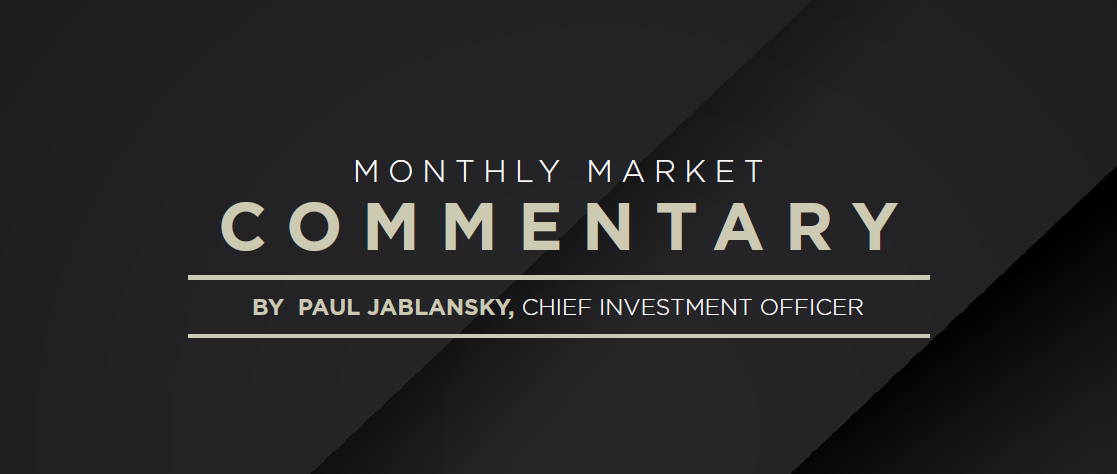Blog
June 2025 Market Commentary

June 2025 Commentary
Thoughts at Mid-Year
Note: Just as we were wrapping up this commentary, Israel unilaterally struck Iran's military leadership, top nuclear scientists, nuclear enrichment facilities, ballistic missile sites, and other targets. This is one of the left-tail geopolitical risks that has lurked in the background for at least two decades. For the financial markets, the immediate impact was an overnight surge in the price of oil. Brent crude was up about 7.5%, though it had been even higher earlier during the night.
Many people ask why the price of oil would rise when there are already heavy sanctions on Iran, effectively limiting their ability to export oil. Despite the sanctions, Iran has remained a significant oil producer, exporting much of its oil at a discounted price to China. So, the question makes sense. The answer is that Iran has the theoretical ability to shut down the Strait of Hormuz, which is incredibly important for the world's oil supplies.
The equity market’s immediate reaction was calm with S&P 500 futures falling less than 1.0% in pre-market trading. Market participants will have to watch ongoing events to get a better understanding of the potential for further escalation. Aside from the obvious geopolitical risks of a war between Israel and Iran, the move in oil prices also has implications for U.S. monetary policy. Energy is a big component of inflation. Higher oil prices mean higher inflation, which could have an inhibitory effect on the Fed's willingness and ability to cut rates.
From an anthropological perspective, the commentary that follows reflects our mid-year thoughts prior to the strike by Israel.
U.S. companies remain among the most profitable and innovative in the world.
As we reach the midpoint of 2025, it’s fair to say this year has already delivered more than its share of surprises. While the broader economy entered the year in decent shape, a series of unexpected policy decisions—most notably the sudden rollout of steep tariffs on April 2nd—triggered substantial market volatility and a noticeable shift in investor sentiment. April 2nd, now commonly referred to as “Liberation Day,” marked the start of an extraordinary week. The S&P 500 dropped 12% between April 2nd and April 8th, bringing the total decline from its February high to nearly 20%. Investors were jolted by the magnitude and abruptness of the tariffs, which were far more aggressive than anticipated and framed as a response to a national emergency.
The government eventually paused the implementation of the tariffs for 90 days, beginning April 9th, giving markets some breathing room. Since then, the S&P 500 has rallied impressively, rising 20% from its April lows through early June. Still, as we write this commentary, the expiration of the tariff pause looms just weeks away, and uncertainty remains high. This period of market turbulence has also reignited a broader economic conversation about “American Exceptionalism”—the long-standing belief in the unique strengths and resilience of the U.S. economy. Some now question whether that status still holds.
We believe that the U.S. continues to possess many of the qualities that have long set it apart. U.S. companies remain among the most profitable and innovative in the world. With an average return on equity of around 20%, they far outpace their counterparts in Europe and Japan. American firms also benefit from a supportive regulatory environment and access to the world’s largest and most liquid capital markets. The U.S. still accounts for roughly two-thirds of global equity market capitalization, and it continues to lead in areas such as artificial intelligence and high-end technology. While the recent tariff policy has undoubtedly shaken investor confidence and created some near-term headwinds, we believe the country’s core economic advantages remain firmly in place.
That said, confidence is fragile. The manner in which the tariffs were announced—with little warning and minimal communication about the magnitude—was unsettling. The policies themselves are disruptive, not only to the U.S. economy but to the global financial system as well. We’ve seen unusual relationships emerge between equities, bond yields, and the U.S. dollar. In fact, the dollar has declined by roughly 10% against both the euro and the yen since the start of the year and we see this trend continuing. With a declining US dollar, a global overweight in US equities, and expectations of narrowing growth differentials, we felt it was prudent to increase exposure to international equities.
In response to these developments, we made several changes to client portfolios. Importantly, we did not alter the overall equity-to-fixed-income allocation. Instead, we adjusted the composition within asset classes to reduce risk and better align with the current environment. On the equity side, we reduced exposure to sectors most vulnerable to the new tariffs, particularly certain cyclical technology and financial stocks. In their place, we increased positions in companies with more stable and/or recurring revenue streams—names like Johnson & Johnson, AbbVie, AT&T, and Waste Management. We also added to defensive financial holdings like Berkshire Hathaway.
In fixed income, we scaled back our exposure to high-yield bonds and increased our allocations to investment-grade corporate bonds, U.S. Treasuries, and government-guaranteed mortgage-backed securities. Given the high level of uncertainty about the direction of interest rates, we’ve focused on bonds with intermediate durations to help manage risk while capturing reasonable yields.
Looking at the broader economic landscape, we began the year with encouraging signs that inflation was moderating, and growth was holding steady. However, the tariff shock has raised concerns about slower economic growth and stickier inflation—a potential scenario known as stagflation. We are now watching two potential outcomes: one in which the economy continues to grow modestly, and another in which growth stalls significantly. Our base case still leans toward moderate growth, but we acknowledge that downside risks have increased. We currently estimate a 30% probability of recession within the next year, which is lower than consensus estimates but still significant enough to warrant caution.
The Federal Reserve is caught between two competing priorities — supporting growth and keeping inflation in check.
Inflation remains a key concern for policymakers. The Federal Reserve is caught between two competing priorities—supporting growth and keeping inflation in check. The market is now pricing in close to 100 basis points of interest rate cuts over the next 12 months, but much will depend on how inflation and growth evolve. In this uncertain environment, we continue to favor high-quality bonds and diversified equity positions.
Artificial intelligence continues to play a central role in market dynamics. While enthusiasm around AI has cooled somewhat from its earlier peaks—particularly due to concerns about market concentration and profit-taking in mega-cap tech stocks—it remains a transformative force. We continue to hold positions in leading semiconductor and software companies that are driving AI advancements, such as NVIDIA, Broadcom, and Microsoft. That said, we’ve also trimmed exposure to the more capital-intensive parts of the sector that are more sensitive to export controls and geopolitical developments.
There has also been increased attention on emerging competition in AI, notably from China’s DeepSeek, a large language model presumably developed at significantly lower costs than its U.S. competitors. While we believe the U.S. remains ahead in AI, this development is a reminder that innovation is global—and leadership must be earned, not assumed.
Finally, while the S&P 500 has had a strong run over the past two years, valuations are now stretched. Historically, high price-to-earnings ratios have been associated with more modest long-term returns. Though that doesn’t necessarily mean a correction is imminent, it does support a more balanced approach going forward. With interest rates at their highest levels in years, we believe that fixed income has once again become a compelling complement—and in some scenarios, a competitive alternative—to equities.
So far, 2025 has been a year of transition and re-evaluation. The world is adjusting to new policies, shifting power dynamics, and a rethinking of globalization. We believe these changes require thoughtful, measured portfolio adjustments rather than reactive overhauls. Our investment philosophy—focused on quality, diversification, and long-term perspective—remains unchanged, even as we adapt to today’s challenges.
Thank you for your continued trust and partnership. As always, we welcome your questions and look forward to helping you navigate the road ahead.
Warm regards,
Paul, Peter, Kristin, Parker, and Rick
Secure Your Financial Future with AWM&T
At AAFMAA Wealth Management & Trust LLC, we are committed to serving the unique financial needs of the military community. Whether you require a complimentary portfolio review, a comprehensive financial plan, assistance with your investment strategy, or trust services, our military wealth management professionals are ready to serve you. Contact us today to set up an appointment with a Relationship Manager who can assess your financial health and customize your personalized action plan.
About Us
Founded in 2012, AAFMAA Wealth Management & Trust LLC (AWM&T) was created to meet the distinct financial needs of military families. We proudly deliver experienced, trustworthy financial planning, investment management, and trust administration services – all designed to promote lasting security and independence.
We are proud to share the mission, vision, and values of Armed Forces Mutual, our parent company. We consistently build on the Association’s rich history and tradition to provide our Members with a source of compassion, trust, and protection. At AWM&T, we are committed to serving as your trusted fiduciary, always putting your best interests first. Through Armed Forces Mutual's legacy and our financial guidance, we provide personalized wealth management solutions to military families across generations.
© 2025 AAFMAA Wealth Management & Trust LLC. Information provided by AAFMAA Wealth Management & Trust LLC is not intended to be tax or legal advice. Nothing contained in this communication should be interpreted as such. We encourage you to seek guidance from your tax or legal advisor. Past performance does not guarantee future results. Investments are not FDIC or SIPC insured, are not deposits, nor are they insured by, issued by, or guaranteed by obligations of any government agency or any bank, and they involve risk including possible loss of principal. No information provided herein is intended as personal investment advice or financial recommendation and should not be interpreted as such. The information provided reflects the general views of AAFMAA Wealth Management and Trust LLC but may not reflect client recommendations, investment strategies, or performance. Current and future financial environments may not reflect those illustrated here. Views of AAFMAA Wealth Management & Trust LLC may change based on new information or considerations.
Get In Touch!
Schedule a consultation with one of our expert financial planners today, and let's hit the fast-track to success!
Schedule A Consultation


